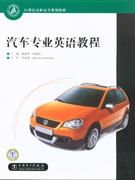-
>
鲍勃·迪伦诗歌集:1961-2012:典藏版
-
>
双城记-英文版
-
>
四级词汇词根+联想记忆法:乱序版
-
>
The secret garden
-
>
哈克贝利.费恩历险记/床头灯英语.2000词读物(英汉对照)
-
>
10000德语分类词汇联想记忆
-
>
英语词汇全书
汽车专业英语教程 版权信息
- ISBN:9787508361383
- 条形码:9787508361383 ; 978-7-5083-6138-3
- 装帧:暂无
- 册数:暂无
- 重量:暂无
- 所属分类:>>
汽车专业英语教程 节选
21世纪不仅给我们带来了信息时代的黎明,也让汽车行业成为国家的支柱产业。
汽车业的突飞猛进及大量的汽车新技术的引进,对汽车专业人才英语水平的要求也越来
越高。根据当前汽车*新技术发展的特点和人才需求,提高汽车专业的学生及汽车行业
人员的专业英语水平已成为当务之急。
本书为了与常见的英语学习模式相衔接,采用对话、课文的形式编排。共分为15
个单元。每个单元紧密配合,又不相互重复。单元内的内容又相对独立,可根据学生的
实际情况调整侧重点。同时每个知识点都编配了练习以帮助学生学习汽车专业英语、熟
悉相关的汽车专业词汇,并提高自己的英语阅读能力。
本书有两条主线:一条是按*新汽车的分类模块介绍其各个机体的结构、原理、电
控系统等,内容包括:润滑系统、冷却系统、启动和充电系统、燃油系统、排放物控制、
防抱死制动系统、辅助约束系统、混合动力车、卫星导航系统等。
另一条主线是按检修维修的实际应用。主要内容包括:基础维修指导、如何排除系
统故障、客户故障分析、症状模拟、电路检测程序、怎样使用诊断故障码图、了解故障
流程图及汽车的保养与维护等。
本书的作者有来自学校的主讲汽车专业的英语教师,也有来自汽车维修一线的维修
高级技师,他们具有丰富的教学与实践经验,以确保本书的教学可操作性、汽车技术的
前瞻性和检修维修的实用性。
主编由北京科技大学的徐莉芳和北京广播电视大学的任冠伟担任。副主编由北京师
范大学的刘大为、北京科技大学的陈永生和北京博瑞凌志汽车销售服务有限公司的杨洪
举担任。还有任东风本田北京国机隆盛汽车有限公司技术服务总监的王振超及北京科技
大学、北京中德培训学校的周军、李海英、王雅殊等参与本书的编写。
本教材在编写过程中,参考了大量的书籍和资料,有些内容难免引自其中,在此
对原作者表示诚挚的谢意!同时对许多同事、朋友给予的帮助与支持,一并表示衷心
的感谢。
编者深知自己才疏学浅,知识有限,书中肯定存在着许多缺点和错误,望广大师生
和读者,及各位专家学者不吝指教,编者在此表示诚挚的谢意。
编 者
2007年8月于北京科技大学
Unit 9 Emission Control
Dialog 1
Bob and Mr. White are talking about the auto emission pollution.
Bob: Uncle, I read an article in China Economic Times about environmental pollution
caused by exhaust emissions.
Mr. White: Oh, what a coincidence. We just talked about that yesterday.
Bob: Yes. The article said that urban air pollution would shift from the current
combination of coal smoke and auto exhaust to mainly auto exhaust.
Mr. White: That is mainly because of the rapid increase use of vehicles.
Bob: Yes, it is.
Mr. White: Besides, many of the obsolete autos have entered the market and continue to
run on the road.
Bob: Do you mean that the obsolete vehicles cause more exhaust emission
pollution?
Mr. White: Yes. I think the strict supervision should be made in the management of
obsolete vehicles.
Bob: And I think we should also try to master advanced technologies to solve the
pollution.
Mr. White: That's for sure. There is a huge gap between the technologies of emission
control in China and those of the developed countries.
Bob: In addition, if fewer cars run on the road every day, there will be less
pollution.
Mr. White: I agree with you. If more people use public transportation, pollution caused by
exhaust emission will be less.
Bob: In that case, ! think I needn't to learn to drive a car. And maybe I should tell
more people to use public transportation to lighten the pollution problem.
Mr. White: Good idea.
Dialog 2
Black is asking the chief inspector, Stanley, to inspect the finished work.
Black: Excuse me, Stanley. What are you busy with now?
Stanley: Oh, I'm writing an inspection report for Mr. Li's Car.
Black: I'm sorry to interrupt you, but would you please take your time to inspect Ms
Wang's car?
Stanley: No problem. That's what I should do.
Black: Well, this is the key and. Please inspect it carefully, you see, she's our new
customer.
Stanley: All right. But I need the auto mechanic to check with me together. Who is
him?
Black: Oh, It's Jim. I'11' call him for you. Wait for a moment.
(After a few minutes)
Jim: Hey, Stanley. I'm here.
Stanley: Hello, Jim. I need you to help me with the inspection work.
Jim: Oh, come on, Stanley. Don't say in that way. We have been working together
for a so long time.
Stanley: Yes, you're right. And I know the work you do is always satisfactory.
Jim: Thank you. But the final in. spection is your job, I'm glad to help.
Stanley: So let's begin now.
Communicative Practice
Ex.! Work with your partner for the conversation
Topic 1: Talking about the pollution caused by cars.
Topic 2: Talking about what inspector do in the auto maintainance company.
Pre-reading
( 1 ) What is the function of the emission control system?
(2) What is the difference between the exhaust system and the emission control
system?
( 3 ) How to test the power of an engine?
Because emission control systems (Fig. 9-1) are designed to limit the pollution
caused by the harmful products of storing and burning fuel, the need to control the
emissions from automobiles has given rise to the
computeriza- tion of the automobile. Hydrocarbons,
carbon monoxide and oxides of nitrogen are created
during the combustion process and are emitted into
the atmosphere from the tail pipe. The crankcase and
exhaust system emit pollutants directly from the
engine into the atmosphere, that is, there are also
hydrocarbons emitted as a result of vaporization of
gasoline and from the crankcase of the automobile.
Emissions frown a gasoline driven motor vehicle
usually come from 4 sources: the fuel tank, fuel injection system, the crankcase, and the
exhaust system. In addition, the fuel tank allows fuel to evaporate and escape to the
atmosphere. These are called evaporative emissions.
The emission control system is an integral part of the engine, and should not be
tampered with or disconnected. This is especially true on vehicles with computerized
engine controls and/or those that must be subjected to mandatory emissions testing. Each
time the engine is started, the computer checks components such as the Oxygen sensor,
catalytic converter and other engine systems are functioning correctly. If a fault is
detected, the MIL is illuminated, indicating that the vehicle needs attention.
- >
史学评论
史学评论
¥13.9¥42.0 - >
莉莉和章鱼
莉莉和章鱼
¥18.1¥42.0 - >
我与地坛
我与地坛
¥16.8¥28.0 - >
诗经-先民的歌唱
诗经-先民的歌唱
¥15.1¥39.8 - >
我从未如此眷恋人间
我从未如此眷恋人间
¥16.4¥49.8 - >
名家带你读鲁迅:朝花夕拾
名家带你读鲁迅:朝花夕拾
¥10.5¥21.0 - >
小考拉的故事-套装共3册
小考拉的故事-套装共3册
¥36.7¥68.0 - >
自卑与超越
自卑与超越
¥13.5¥39.8
-
汉译英基础教程:外语院校翻译系列教材
¥8.6¥27 -
财政学专业英语
¥9.5¥28 -
2022图书×抽奖盲袋
¥9.9¥25 -
2023读书月阅读盲盒——天黑,闭眼,刀谁?
¥42.3¥158 -
2022读者节纪念徽章-三星会员专属
¥45¥45.6
















